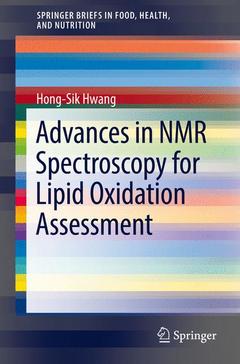Description
Advances in NMR Spectroscopy for Lipid Oxidation Assessment, 1st ed. 2017
SpringerBriefs in Food, Health, and Nutrition Series
Author: Hwang Hong-Sik
Language: English
Subjects for Advances in NMR Spectroscopy for Lipid Oxidation Assessment:
Support: Print on demand
Description
/li>Contents
/li>Biography
/li>Comment
/li>
This Brief provides a comprehensive overview of NMR spectroscopy, covering techniques such as 1H, 13C, and 31P NMR, which are reliable tools to determine lipid oxidation level, to identify oxidation products, and to elucidate oxidation mechanism. The Brief shows that 1H NMR spectroscopy continually demonstrates reliability, accuracy, convenience, and advantages over conventional analytical methods in determination of the level of oxidation of edible oil during frying and storage through monitoring changes in several proton signals of oil, including olefinic, bisallylic and allylic protons. This modern analytical method is shown within this text to be used to identify oxidation products, including primary oxidation products such as hydroperoxides and conjugated dienes and secondary products such as aldehydes, ketones, epoxides and their derivatives. By identifying intermediates and final oxidation products, many oxidation mechanisms could be elucidated. A relatively newer method, the text demonstrates that 13C NMR and 31P NMR spectroscopy can also provide additional information on the molecular structure of an oxidation product. Backgrounds, principles, and advantages over conventional methods, most recent advances, and future prospects of these methods are discussed.
Advances in NMR Spectroscopy for Lipid Oxidation Assessment begins by covering the various mechanisms of lipid oxidation, including various methods to determine oxidation products. NMR spectroscopy is then covered, including its applications in foods. The next section focuses on 1H NMR Spectroscopy, including its use for assessment of lipid oxidation during oil storage and frying. The following section focuses on 13C NMR spectroscopy, including its use in determining and identifying oxidation products and mechanisms. A final section focuses on 31<
1. Conventional Analytical Methods to Assess Lipid Oxidation and Their Problems
1.1. Mechanisms of Lipid Oxidation
1.2. Methods to Determine Primary Oxidation Products
1.3. Methods to Determine Oxidation Products2. Application of NMR Spectroscopy in Foods and Its Advantages
3. 1H NMR Spectroscopy for Assessment of Lipid Oxidation
3.1. Assessment of Oxidation during Oil Storage
3.2. Assessment of Oxidation during Frying
3.3. Comparison between 1H NMR Spectroscopy and Conventional Analytical Methods
4. 1H NMR Spectroscopy for Identification of Oxidation Products and for Elucidation of Reaction Mechanisms 5. 13C NMR spectroscopy for Assessment of Lipid Oxidation 5.1.Use of 13C NMR spectroscopy for Determination of Oxidation5.2. Use of 13C NMR spectroscopy for Identification of Oxidation Products and Mechanisms
6. 31P NMR spectroscopy for Assessment of Lipid Oxidation
7. Conclusions and Future Prospects
References
Index
Dr. Hong-Sik Hwang is a Research Chemist at the National Center for Agricultural Research at the US Department of Agriculture in Peoria, IL, USA.
Provides a comprehensive overview of NMR spectroscopy for lipid oxidation assessment in foods
Details NMR Spectroscopy in foods and its advantages for assessment of oxidation during both oil storage and frying
Covers both 13C NMR and 31P NMR spectroscopy and their uses in determining and identifying oxidation products and mechanisms
Includes supplementary material: sn.pub/extras



